#Crystal Habitats
Explore tagged Tumblr posts
Text
It's very funny to compare the treatment of pacifism in Hermitcraft and the Lifesteal SMP, especially when considering the stereotypes related to those SMPs.
Like if I made the average MCYT fan (who's not watched either) guess which series featured a long drawn-out roleplay arc of what it means to be a pacifist, whether being a pacifist means you need to take a passive role in what's going on around you, complemented by some gorgeous thematic builds and giant megafarms and what server had someone try to become a pacifist, on a whim for a vacation, before realising how much they actually enjoyed killing and then their arc revolved around the idea of killing as many things as possible, I think they'd just not believe me.
#LSSMP#Lifesteal SMP#Hermitcraft#and the funniest thing is you can apply what I said to both Subz and Zam in a sense#this post is NOT arguing for Mumbo in Lifesteal btw#that server is not his natural habitat and I think he would get very stressed out about it#also crystals are banned there lol#but I AM arguing for Zam in Hermitcraft I think that would be funny
65 notes
·
View notes
Text
"She glanced back to where she'd left Maul, but he had already vanished. She waited. Barely ten seconds later, Kilindi heard a horrific scream from atop the cliff." (Windham, 95).
Kilindi and her bestie the eldritch horror
#Kilindi is a cross between hardened military commander and creepy girl who uses ouiji boards to talk to demons#and maul is the demon lol#i love their friendship so much#everyone just gets rancid vibes from maul but she's thriving this is her habitat#actually i need an au where she is a witch and he is the demon familiar#the jedi characters can be state-sanctioned wizards or something#and theyre both there painting their nails saying 'GURLL' to each other when they see another obi-wan flop in the crystal orb#the wrath of darth maul#maul#kilindi#notes & quotes#chapter 9#funny#yes im preserving my own tags this is hilarious
17 notes
·
View notes
Text
Natural Crystals by Team Planting
Do you believe in the power of natural crystals? Have you ever heard of their power? I admit that, although I have heard the claims over the years, I’ve never paid much attention to them. Recently, I read about Team Planting and their efforts to improve our general and mental health as well as the environment. What do the two have in common? If your curiosity is piqued like mine was, read…

View On WordPress
#Loreeebee#teamplanting#crystals#extinction#habitat restoration#jewelry#karma#natural crystals#reforestation
1 note
·
View note
Text
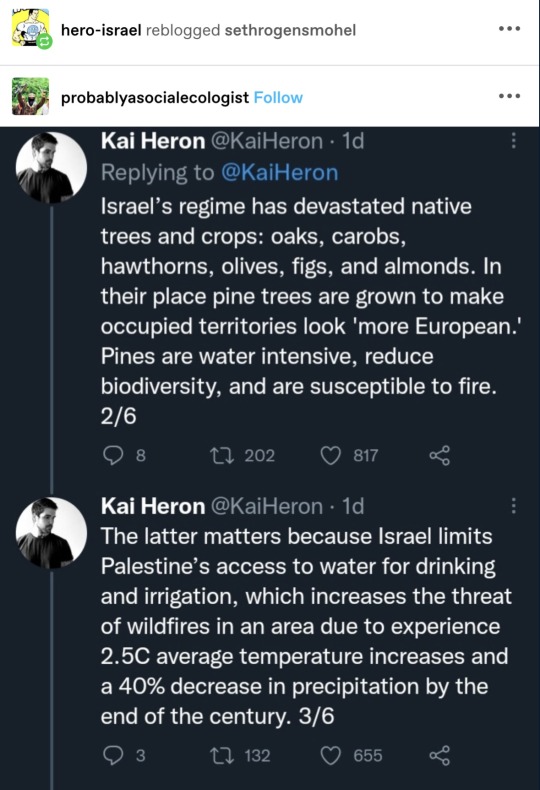

This is pseudoscience where it isn’t actively anti-science.
The pines planted in Israel are Aleppo pines, which are indigenous and have been recorded by observers for literally millennia. Far from “devastating” native oaks and carobs and whatever, Israel planted tons of those varieties too. And there can be no discussion of the well-being of Israeli forests without noting that Palestinian militants are highly proficient at arson and have practically made mountainous tire-fires their trademark.
As for the idea that the Zionists were “trying to create European-style forests” - the implication that the local environment was “normal” before they “changed” it is entirely a social construct reeking of unexamined privilege. The Roman Empire massively deforested Israel along with the rest of the Mediterranean. Our popular concept of the Middle East as a land of desert and scrubland is artificial, but comes naturally to people who think the world began in like 1700.
The Palestinian mountain gazelle is indeed endangered in Israel, and some of their populations are jeopardized by habitat and genetic fragmentation caused by the West Bank barriers. However, the largest and most stable population of the species is found in the Golan Heights, where they roam freely without such barriers and have enjoyed a significant rebound in numbers now that they are no longer subject to hunting from Syria. More importantly, the Palestinian mountain gazelle has already been wiped out in Egypt, and also in Syria and Jordan - perhaps some invisible Mossad agents went on safari? The species was on the brink of extinction in Turkey, until it was quite accidentally saved when the Turkish military set up a no-man’s-land on the border with Syria in response to its civil war.
It’s also worth noting that the first post in that Twitter thread (not screencapped onto the Tumblr post, hmm...) was Heron calling for BDS. When Israel really is the only country in that region where forest cover is growing and where the mountain gazelles have any chance at survival, uh, why should we overthrow the government, again? That would help the environment how, precisely? The Kai Herons of the world would call that “greenwashing,” because they don’t actually give a shit about the environment, they just misappropriate journal-jargon to mask how ridiculous and unprincipled their accusations are.
Last and least, the concept that “Palestinian liberation is a climate issue” is just a perfect crystallization, French waiter palm-kiss, of how lefty activists try to run in every direction at once and get nowhere. Climate protection has failed because it requires the entire world to unfuck foundational problems in our economic, technological, and political lives - but Palestinian liberation is still a matter of a signature and a handshake, two parties looking at made-up lines on a very small map. For white European activists to insist that Palestinians may only make progress if we first make progress on climate change just shows how they only see Palestinians as tools and symbols and not as people.
CODA:
This is a case of me being ABSOLUTELY fucking petty enough to reconstruct and restart a post after someone blocked me and prevented reblogs of the original.
For more on the pseudoscience and anti-environmentalism of Palestine activists see lots of links here. For more on the actual environmental history and diversity of the region, see the tags.
371 notes
·
View notes
Text
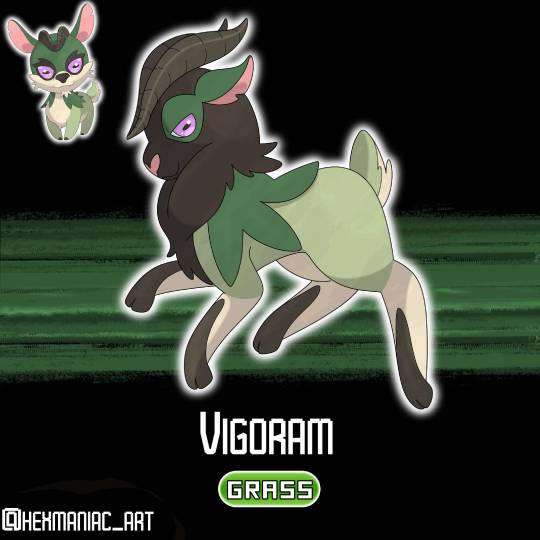
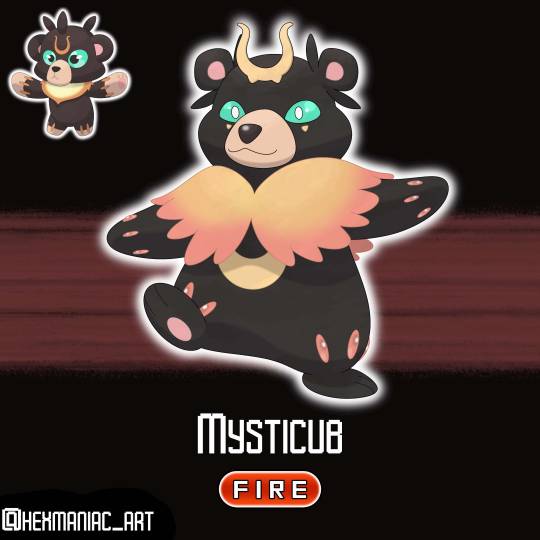

Your Starter Pokémon have evolved!
Vigoram, the Brigand Goat Pokémon
Vigoram are cheeky and boisterous Pokémon, and wild ones are known for luring Trainers close with their cute appearance and then headbutting them to steal food to give to their friends.
Its horn and hooves are made of oak and can puncture steel with enough force.
Outlaws in the past used this Pokémon to steal goods from high class carriages to redistribute to the poor and needy.
Mysticub, the Familiar Bear Pokémon
Mysticub are peculiar Pokémon and are seldom seen in the wild. Rare sightings of this Pokémon tell of it gathering and burning herbs, wafting the smoke around its habitat. Some believe many rituals in witchcraft were adapted by observing the behaviour of Mysticub.
The flame sacs around its limbs have pressurised into crystals during evolution.
The flames it produces are said to heal as well as harm.
Gruffaneer, the Sailor Bat Pokémon
Gruffaneer are hardy Pokémon and enjoy nothing more than traversing through rough sea storms as a show of strength, and are often found amongst the crew of ships thanks to their expert navigational skills.
The yellow patterns on its body can illuminate at will, and sailors have learnt to understand this Pokémon by observing the sequences in which the patterns light up.
Gruffaneer can battle both in the air and beneath the waves, thanks to its wings that have evolved to double as fins, similar in appearance to that of a ray fish.
#pokemon#pokemon fan art#my art#pokemon art#fakemon#fakemon art#starter pokemon#starter fakemon#grass type#fire type#water type#pokemon fan region#unoki region
96 notes
·
View notes
Text
The Siren, or The Heart of the Matter Masterlist
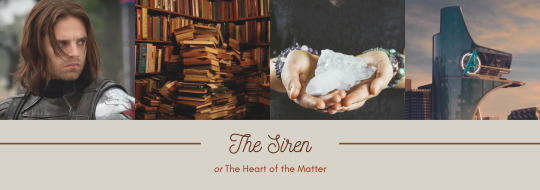
Pairing: Bucky Barnes x OFC
Tags: Romance, fluff, smut, mental health, healing from trauma, enemies to lovers, slow burn, canon-typical violence, angst with a happy ending.
MINORS DNI.
* This story is complete *
Chapter Directory:
The Book, or Inez is a Fucking Goddess
The Mission, or Is Barfing on Captain America's Shoes Treason?
The Hospital Room, or Give My Best to Ovid
The Beginning, or Tin Man, Beefcake, Man Bun, and Natasha
The Beginning's Beginning, or The Abridged and Heavily Redacted Life and Times of Cleo Blake
The Crystal, or Cleo's Mother is Right for the First Time in Recorded History
The Neighbor, or Meg's Goldfish Might Need a New Godmother
The Assignment, or In Defense of the Mighty Ovary
The Lie, or The Truth Without the Calories
The Run, or To the Window, to the Wall, 'Til the Sweat is Fucking Everywhere
The Test, or Clint's No Good Very Bad Day
The Power, or The Mandatory Forced Proximity Event
The Theories, or Overwhelmed by the Power of Quarterflash
The Question, or I'll Make an Avenger Out of You
The Name, or A Return to My Natural Habitat
The Philosopher, or If You Want Peace, Prepare for War
The Phone Call, or Hey Look, Ma, I Made It
The Text, or As Easy as Biting off Your Own Finger
The Bar, or Good Company and Bad Jokes
The Interruption, or An Abundance of Party Crashers - Part One
The Interruption, or An Abundance of Party Crashers - Part Two
The Haircut, or Level Two Friendship Activities
The Appointment, or Therapy is One Hell of a Drug
The Lamp, or Making a Habit
The Visitor, or Eight Harry Potter Movies and One Second of Bravery
The File, or Secrets, Sparring, and Escapes
The Fuck-Up, or The Road so Far is Full of Mistakes
The Friend, or Low Times at Sneaky Pete's
The Moment
The Note, or The Thesis Defense from Hell
The Soldier, or I Fucking Love You
The Intervention, or Righting Some Wrongs
The Miracle, or Ten Words and a Thousand Kisses
Bonus Content:
Character Doodle - Cleo
Avengers Karaoke Jams Playlist
Character Doodle - The Siren Suit
Character Doodle - The Philosopher
Angry Feminist Killjoy Playlist
Poll - What comes next?
Character Doodle - The Siren Suit with Helmet
#fanfiction#fanfic#marvel fanfiction#mcu#marvel#mcu fanfiction#james buchanan barnes#bucky barnes#bucky barnes fanfiction#enemies to lovers#slow burn#original female character#original superhero character#mental health#ptsd#healing from trauma#cross posted on ao3#steve rogers is a good bro#implied sa#canon typical violence#natasha romanov is a good bro#clint barton is a good bro#angst#the siren#the heart of the matter#protective bucky barnes#angst with a happy ending#smut#bucky barnes smut
103 notes
·
View notes
Text
Crystal: And here we see Edwin and Charles in their natural habitat. Texting each other variations of the word "garlic bread" to try to make each other laugh. Edwin: Gaelic bread. Charles: Grueling brad. Edwin: Ha ha, glamorous beans.
#Dead Boy Detectives#Charles Rowland#Edwin Payne#Crystal Palace#Incorrect Dead Boy Detectives Quotes#Incorrect Quotes
153 notes
·
View notes
Text
Hopelessly Devoted
Roman Reigns x Multiracial OC
Part one: Returning to Fook Island



Summary: A year ago, Joe met Princess Pensri on Fook Island, and they quickly fell in love. Unbeknownst to her, Joe paid her bride price, planning to marry her. Now, he returns with his family to fulfill his promise, ready to begin their life together.
A year had passed since Joe first set foot on the lush, mysterious soil of Fook Island, an island draped in the sort of serenity that seemed to exist only in fairy tales or the rarest of dreams. What had seemed like a typical vacation, a chance to escape the daily grind and immerse himself in new experiences, had turned into something far more profound. A journey of fate and destiny. It had begun with an impulsive decision to visit Fook Wildlife Sanctuary, a decision that would soon intertwine Joe’s life with a woman who, unbeknownst to her, had become the center of his world. A woman who had become his future. The love of his life.
Her name was Princess Pensri, the third in line to the Fookian throne and the enigmatic owner of the sanctuary, a haven dedicated to protecting endangered species and preserving the delicate balance of Fook Island's lush ecosystems. A year ago, Joe had no idea that this regal, poised woman, whose presence commanded the respect of everyone around her, would leave an indelible mark on his heart.
He had wandered through the sanctuary on his first day, captivated by the vibrant flora and the sense of awe that arose from the sight of wild animals in their natural habitat. But nothing had prepared him for the moment when he met her. Pensri had approached him as he stood gazing at a group of tigers, their powerful bodies lounging in the sun, their eyes half-closed in contentment. She was serene, yet there was a spark in her eyes, something unmistakable, a sense of duty and grace that blended with an unspoken warmth. Her smile, when it came, was warm and inviting, a contrast to the royal demeanor she wore with ease.
Their conversation had flowed effortlessly, as if the universe had conspired to bring them together. They spoke about the sanctuary, about the island, about the wonders of nature. But as the day unfolded, they spoke more about each other. There was something undeniably magnetic about her, something that drew Joe in. He wasn’t sure if it was her beauty, her intelligence, or the way she seemed to connect with the world around her, but there was no denying the pull. It felt as though fate had orchestrated their meeting.
By the end of the tour, the bond between them had deepened. Pensri, despite her royal lineage, was far from aloof. She was down-to-earth, unpretentious, and passionate about her work. But there was something more, something in the way she spoke, the way she looked at him, the way she listened. It was as if the universe had opened up just for them. Joe had always believed in love at first sight, but never had he experienced it quite like this. It wasn’t just the spark of attraction; it was the sense that something larger was at play.
The days that followed were a whirlwind. They explored the island together, swam in crystal-clear waters, dined under the stars, and laughed until their cheeks ached. Joe found himself completely taken by Pensri, by her passion for wildlife conservation, her unshakable devotion to her people, and her deep connection with nature. He learned that she was not just a princess in title, but in spirit. Her love for Fook Island was palpable, and her respect for the land and its creatures was evident in every action she took.
During that magical week, Joe had been able to do something that only a few people in the world ever had the privilege of doing: he had named a group of tigers in the sanctuary after himself and his cousins. It had been a moment of sheer delight, a moment of connection not just with the tigers, but with the island and the life he was beginning to envision with Pensri.
As they shared those intimate moments, Joe realized that he had fallen in love with her. Truly, deeply, and irrevocably. But there was more to it than just love. There was something he had come to understand about himself and his future. He could not imagine his life without her. He knew, deep in his soul, that she was the one.
It was in the quiet of one evening, as they sat side by side watching the sun dip below the horizon, that Joe made a decision, one that he had not taken lightly. Pensri, with all her grace and elegance, did not know that in the quiet corners of his mind, Joe had already planned his future. While she was still unaware, he had secretly made the arrangements to pay her bride price, a tradition in her culture, which would ensure that she could marry him. In a way, he had already committed to her, even before she had a chance to say yes.
That night, beneath the blanket of stars that stretched across the island like an ancient tapestry, they shared a kiss that sealed their bond. The kind of kiss that spoke volumes without a single word. It was an unspoken promise of a future together. A promise that Joe would honor, no matter the distance or the obstacles that might arise.
A year had passed since that life-changing vacation, and now, Joe was returning to Fook Island. But this time, he wasn’t just a tourist. He was returning to marry the woman he loved, the woman who would soon become his wife. The woman who, unknowingly, had already become his forever.
As Joe sat in the back of the car, the island’s warm breeze tousling his hair, he couldn’t help but feel a mixture of excitement and nervousness. He had spoken to Pensri only a few times since their week together. They had exchanged phone calls, messages, and gifts, but the anticipation of seeing her again, of holding her in his arms, filled him with an overwhelming sense of joy.
The car bumped along the winding roads of Fook Island, and as they neared the sanctuary, memories from that fateful week rushed back to him in vivid detail. The scent of the jungle, the warmth of the sun on his skin, the sound of the waves crashing against the shore. It was all so familiar. It felt like home.
As they approached the sanctuary’s gates, Joe’s heart began to race. He had spent the last few months preparing for this moment, arranging everything with Pensri’s family, speaking with the elders, ensuring that all the traditions would be respected. He had brought his own family with him, eager to witness the wedding and show their support for the union. But even with all the preparations, he felt a sense of nervousness. After all, this was more than just a wedding, it was the beginning of his new life.
The car finally came to a stop, and Joe stepped out, his eyes immediately scanning the familiar surroundings. He could see the tigers in the distance, their striking eyes peering from behind the trees, just as they had a year ago. But his gaze soon fell on her, the one person who had captured his heart in ways he never thought possible.
Pensri stood in the doorway of the sanctuary’s main building, her presence as commanding as it was graceful. She was dressed in a traditional gown, her dark hair cascading over her shoulders in waves, her eyes shining with a mixture of joy and nervousness. As their gazes met, time seemed to slow. Joe could feel the pull of her presence, just as he had felt that first moment they met. The world around them fell away, and all that mattered was the woman before him.
Pensri stepped forward, her smile lighting up the space between them. Joe felt his chest tighten with emotion as he walked toward her, his feet moving almost as though they had a mind of their own. When he finally reached her, he pulled her into his arms, his heart swelling with a happiness he had never known before.
“I’m here,” he whispered, his voice thick with emotion.
Pensri pulled back slightly, her eyes glistening with unshed tears. “You came back,” she said softly, as though she couldn’t quite believe it.
Joe nodded, his heart full. “I promised I would.”
And as he held her, surrounded by the beauty of the sanctuary that had brought them together, Joe knew that this was where he was meant to be. This was the beginning of the rest of his life.
Everything had led him to this moment.
Masterlist | Part two: A Dance of Destiny
#hopelessly in love#hopelessly devoted#woc#wocsource#fanfic#wrestling#wwe#wwe fanfiction#fanfiction#wwe fic#roman reigns fluff#roman reigns x oc#romance#roman reigns fanfiction#roman empire#roman reigns#the tribal chief#princess#the head of the table#the samoan dynasty#roman reigns fic#roman reigns fanfic#Spotify#multiracial#the bloodline#oc#wrestler#wrestling fanfiction
83 notes
·
View notes
Text
results of a quest to identify the cicada in dnp’s rodent boy summer instagram post
[video: an audio comparison of dan howell's mediterranean cicada imitation and two real cicada species from the med]
abstract: following a perceived dearth of interest in the cicada latched onto the wall in one photo of the ten in dan and phil’s most recent joint vacation instagram post, the authors of this post (buskingalbatross and an anon who instigated this quest) have endeavored to determine its identity at the species level. using resources such as naturalism networking site iNaturalist, various scientific research articles, a databank of Mediterranean cicada song audio files, and Dan’s imitation of cicada screams in the AmazingPhil video “How Phil Nearly Died,” we have concluded that the cicada is most likely an East Aegean cicada (Cicada mordoganensis). obtaining these results would have been impossible had we not received assistance from @/bitchslapblastoids, who generously provided the herein unnamed geographical location* of dan and phil’s summer rat and relaxation destination. I would also like to thank @/pierogish for providing feedback on comparisons of cicada audio files with Dan’s cicada noises.

[image: the individual in question]
methods, results, and conclusions below the cut.
*the authors of this tumblr post would like to flaunt their scientific achievements unencumbered by potential discourses surrounding the unearthing of this location, and thus have chosen to omit its name from this post. the authors of this tumblr post nevertheless understand that the location can be discerned by those curious enough to discern it. the authors moreover state that they harbor no wish to compromise dan and phil’s privacy.
methods and results
iNaturalist’s search feature was used to gain an awareness of what species of cicadas have been observed on the mediterrranean peninsula where dnp went on holiday. a spreadsheet was created to organize data such as cicada common names, scientific names, the number of observations for any given species, the reliability of those observations (that is, how likely the observer was to have correctly identified a cicada; a high quality identification is referred to on iNat as a research grade ID), the period of time in which a species is the densest in numbers (most prevalent in its aboveground habitat), appearance, and, finally, a link to an audio file containing each cicada species’ song. audio files were the last piece of data to be acquired, and so were added to the spreadsheet very last.
once a list of species had been determined and entered into the spreadsheet, we compared the appearences of each candidate cicada species to dnp’s instagram image. all in all, we looked at seven cicada species: the black sorrow cicada (Cicadatra atra), the ash cicada (Cicada orni), the common cicada (Lyristes plebejus), the red cicada (Cicada haematodes), the east aegean cicada (Cicada mordoganensis), the geminate cicada (Lyristes gemellus), and Cicada lodosi (a species name now possibly defunct but with 4 observations in the area of interest in the past five years).
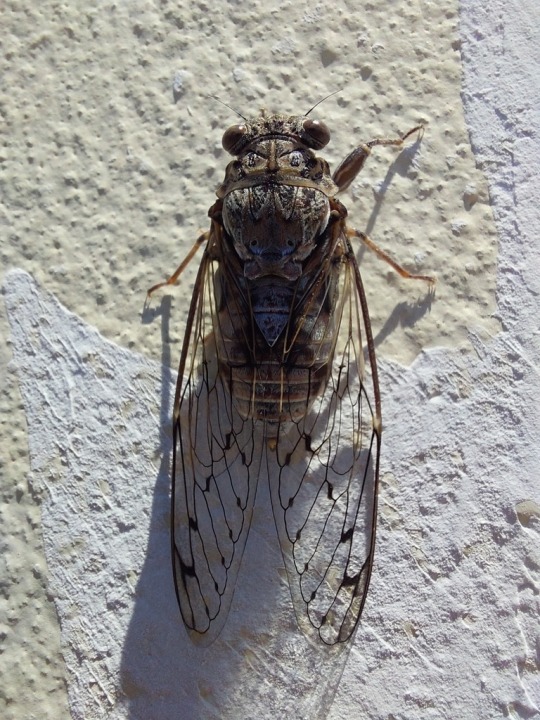

[images: left - the east aegean cicada; right - the ash cicada]
then, I decided to read a truly excessive number of scientific research papers about cicadas in the mediterranean. why did I do this? besides reasons of entomology-associated passion (and legitimate professional interest), I did it because I learned that it turns out that basically, the aegean sea constitutes a “hot spot of cicada diversity,” with numerous species across different genera that nevertheless look—pretty much all the same! quite quickly, it became apparent that one blurry instagram image would be insufficient to determine the species. in fact, even if the image had been crystal clear, it wouldn’t have mattered. apparently, many cicadas of the eastern mediterranean are not morphologically distinct (meaning, again: some of them look identical) and what differentiates them is actually, primarily, their songs. they are “acoustically divergent,” with females being able to locate males of their own kind by their unique calls alone, not their looks. different species also tend to be distributed differently across this region, by which I mean some are only found on certain islands, or in certain areas of Italy, the Balkans, Greece, or Turkey, or Greece and Turkey, etc etc. I needed to read to form a better picture of all of this, essentially, and to gather clues.

[image: some of the papers I read]
after perusing all of this fascinating literature—and also squinting really hard at dnp’s picture and the photos of cicadas we had accumulated—I came to the conclusion that, most likely, the cicada was either Cicada orni, the ash cicada, or potentially more likely, Cicada mordoganensis, the east aegean cicada. both had three observations recorded in the region of interest (the most observations of any species), and both had the most similar coloration and patterning to dnp’s cicada. my predilection for the east aegean choice stemmed from two things: 1. the east aegean cicada observations were of a higher quality (research grade) than the ash cicada, and 2. the papers I had read were telling me that while east aegeans were prevalent along the entirety of the our region of interest, ash cicadas were more constrained, geographically, to northern Turkey and the Greek mainland. in fact, according to mediterranean cicada scientists, no ash cicadas had ever been found on islands as southeast as Samos and Ikaria, two islands relatively close to the peninsula where dnp’s cicada resides. this contradicted the observations on iNaturalist.
apparently, this difference in distribution has a lot to do with the tectonic and geographical history of the eastern mediterranean. where certain cicadas are today has a lot to do with where warm refuges from ancient glaciers existed thousands and millions of years ago (cicadas like the heat). also, and I should not necessarily subject you to this tangent, but did you know that about 5 million years ago the mediterranean sea simply gave up on existence for a little while? ... during the Messinian Salinity Crisis, the mediterranean simply stopped being a sea for a little while and almost dried up completely, allowing certain creatures that could not otherwise traverse an entire sea to disperse across it, except for where there is a huge ass canyon in the seafloor, and—




[images: highlighted, pertinent sections of papers discussing cicada distribution; relief map of the mediterranean seafloor]
anyway, what we were sorely missing at this stage were sound recordings of the cicadas. despite the evidence against the ash cicada, this cicada is still one of the most commonly found cicadas around the aegean sea. also, some of the studies I found were ten or more years old—who knows how climate change or other factors may have impacted the location of cicada populations since they were published.
while the audio of the cicadas outside in Phil’s video is poor, Dan does an imitation at 00:30 of what they’d been hearing during their trip. knowing Dan, this imitation is not merely a made-up, vaguely cicada-like noise, but an actually good approximation of the song that had been driving them crazy (this whole study mayhaps hinges on this lmao). if only we could uncover audio of these cicadas, maybe we could know for sure if this insect was of the ash or east aegean variety.
thankfully, at this point I was still reading papers. even more thankfully, the ten individuals who seemed to have cornered the market on mediterranean cicada studies since the 1970s made a website, and mentioned it in one of their papers. it is an exceptional, beautifully designed website called cicadasong.eu that evokes the ad-free, uncluttered, cozy and homemade feeling of the early noughties internet. it almost made me cry, and @/pierogish reported that seeing this website made her realize that in all these years recently spent online she had been choking, and only on cicadasong.eu was she finally able to breathe freely. on this website, there happen to be embedded YouTube videos of high quality audio recordings of all the european cicadas its creators have ever studied.
at last! comparisons of cicada songs to Dan commenced, and we were able to play the ash cicada’s sound alongside the east aegean’s and Dan’s. at the top of this post, you will find the compilation of these three sounds. here are the links to the original audio videos of the east aegean and ash cicada.
the main unit of sound—the chirp—of a cicada’s song is known scientifically as an “echeme”. in these audio files, you can perceive that, for the east aegean cicada, the duration of the echeme is longer, meaning the number of echemes per second is lower. this rhythm, and in general the structure of the east aegean cicada’s song was, in comparison to the ash cicada’s, deemed to the ear of all the authors and contributors definitively more similar to dan’s cicada song. thus, this final piece of evidence seemed to complement the rest of our data and confirm our initial assumption of the cicada’s identity.
conclusion
accumulated data has lent support to our hypothesis that the cicadas suffusing the atmosphere of dip and pip’s holiday resort with their ebullient, lascivious songs were east aegean cicadas.
#dnp#my regularly scheduled science/animal-themed contribution to the community#dan and phil#cicadas#entomology#insects#bugs
247 notes
·
View notes
Text
Denizens of The Sunken: Type Wheel, KEMC Diamond, and Habitats
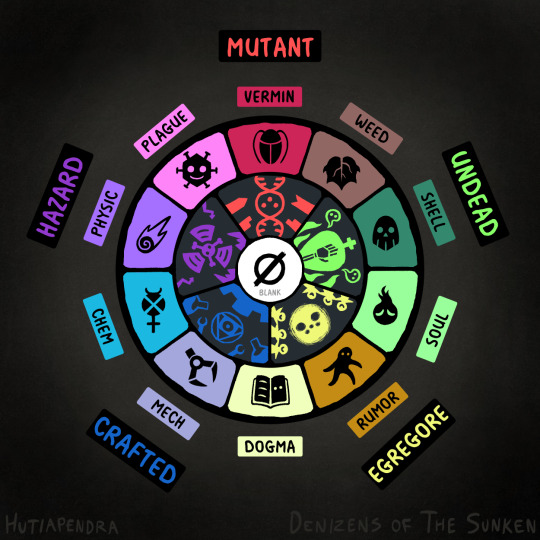
Some researchers have asked what all the graphic icons in our encyclopedia entries mean. The following document should explain them all.
PART 1: THE TYPE WHEEL
The creatures populating the Sunken Island can be classified under ten (eleven) different Types, and five (six) different Cores. This diagram illustrates the relationships between Types and Cores.
The inner wheel contains Cores, the intrinsic origins of a creature. The outer wheel contains Types, the modes of a creature’s existence. Cores have certain Types associated with them, though a creature may deviate from these common links entirely.
Cores:
MUTANT: Life as we know it, twisting and accelerating beyond explanation.
UNDEAD: That which is no longer alive, echoes clinging to this world.
EGREGORE: Collective concepts brought to life, human ideas.
CRAFTED: That which was deliberately built, taking on life of its own.
HAZARD: Life inimical to other life, parasites, forces of nature.
Types:
VERMIN: Beasts. That which scurries, scratches, consumes. The rage of a thousand cornered rats.
WEED: That for which growth and movement are one and the same. Plants. Fungi. Sessile animals.
SHELL: Corporeal undead. Cadavers. Dust. Fossils. Rot. Food.
SOUL: Incorporeal undead. Ghosts, grudges, hauntings. Aftershocks of history.
RUMOR: Beings born from whispers. Legends. Cryptids. Bogeymen. Fear. Uncertainty given flesh.
DOGMA: Beings born from rules. Philosophy. Religion. Information. Code. Conviction given flesh.
MECH: Automata. Mechanical monsters free to self-replicate, free from their origins in human factories.
CHEM: Homunculi. Chemical processes running rampant. Water, salts, fuel, coarse stone, refined crystals.
PHYSIC: Forces of nature. Extreme heat and cold. Storms. Blunt impact. Distant stars. Disasters passively harmful to life.
PLAGUE: Invaders. Parasites. Infections. Consumers from within. Pestilence actively harmful to life.
Blank:
A Type and a Core at the same time, Blank is defined by absence. Some would call this a 'normal' or 'neutral' attribute, but there is nothing normal about a creature devoid of an identity. What little unites these Denizens involves empty vacuums, blistering cold, and unfilled vessels. Blank creatures are rare, and they tend to behave oddly when exposed to other life forms.
-----
PART 2: THE KEMC DIAMOND
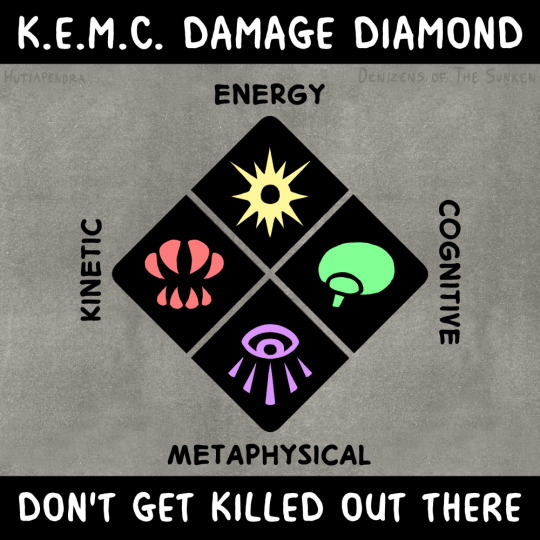
Damage varieties:
All Denizens have the ability to inflict harm on others. That includes you, reader. Please familiarize yourself with the risks inherent to field research before going outside to catalogue the wildlife.
KINETIC: Harm inflicted with physical means, such as claws, fists, fangs, or infection. By far the simplest form of danger to understand, but no less deadly.
ENERGY: Harm inflicted by emitting high levels of energy through comparatively small amounts of mass. This may take the form of fire, electricity, radiation, among others.
COGNITIVE: Harm inflicted by assaulting the mind and senses. Creating illusions, manipulating emotions, and altering memories all fall under this category.
METAPHYSICAL: Harm inflicted by locally rewriting the rules of reality. What was fiction a moment ago is now a fact of life, and yesterday's laws of physics are today's fairy tales.
-----
PART 3: HABITATS
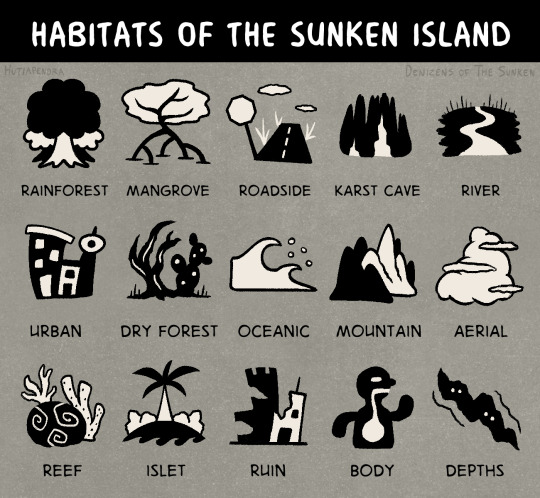
The icons above represent the various environments a Denizen may call home. The Sunken Island is very humid and situated well within the tropics, so many habitats such as deserts and glaciers have never been present here. Other icons may be added to the Denizen Encyclopedia if those presented are insufficient.
-----
That should cover everything, for now. If you have any other questions, please direct them my way!
-Dr. Calypso Ceiba, Postdoctoral ecologist for the Denizen Project
152 notes
·
View notes
Text
December 17th, 2023


Scaly-foot Gastropod (Chrysomallon squamiferum)
Distribution: Found exclusively in the Indian Ocean.
Habitat: Lives in deep-sea ridges, at a depth of around 2800 metres, around hydrothermal vents.
Diet: Does not feed; forms associations with chemotrophic gammaproteobacteria that provide it with nutrition.
Description: Also known as the volcano snail or sea pangolin, the scaly-foot gastropod is named for the armor-like sclerites found on either side of its foot, composed partially of mineralised iron. Its shell is just as unique, composed of an iron sulphide outer layer and an inner layer composed of aragonite (which is a type of calcium carbonate crystal often present in the shells of molluscs and in coral). It's the only animal known to use iron sulfide in its skeleton.
Because it doesn't feed, this snail species has a remarkably small radula, a tongue-like structure many snails use to scrape rocks or exoskeletons to access food and nutrients. The bacteria housed in its body are autotrophs, much like cyanobacteria or plants—except, in this case, they use the chemicals present near hydrothermal vents to produce energy.
This species is listed as endangered, as its habitat is a prime target for deep-sea mining.
(Images by Dr. Chong Chen and David Shale)
502 notes
·
View notes
Note
LET US OUT OF THE CELLAR!!! We want to have lives!!!! Also I’d like some shrimpo hcs please
- 🌈🌸 anon, very much stuck in the basement
No.... you gotta stay in containment.... sorry bro...
Shrimpo... let's see here!
I like to imagine he's roughly based off of a Freshwater Dwarf Shrimp!

This species specifically, I believe, is called either the Crystal Red Shrimp or the Red Bee Shrimp!
2. Freshwater Dwarf Shrimp are most commonly omnivorous! Shrimpo seems like the type to stock up on a lot of protein. You see, I really like fish, so when I get the opportunity to be specific, I seize it! I'm aware Shrimpo is necessarily just a shrimp TAIL, but come on! You can't tell me this little guy wouldn't be an amazing fit for him!
3. Oxygen content and water being at the perfect balance is a really important survival requirement for shrimp, so I like to think he would routinely soak in water for a few hours before heading back out into the oxygen due to this important ratio. He probably denies wanting to go into the water because -- presumably, if non-mains have handlers -- his handler tells him to, and as we know, he is defiant and a hater, but he would actually enjoy the soak.
4. When he sees vegetation in water, like in aquariums, he likely feels oddly reminiscent with no real idea why -- and this is because a lot of the habitats shrimp are found in are filled with dense and diverse vegetation!
5. Shrimp typically have a keen sense of predator avoidance, and considering Shrimpo is a shrimp as well, I like to imagine that he has a very strong sense of what danger lurks nearby, almost like a spidey-sense of sorts!
6. He probably doesn't ACTUALLY hate everyone and everything -- I've seen a lot of neurodivergent Shrimpo headcanons and honestly, I agree. He likely doesn't know how to properly regulate his own emotions or how to express them properly, and I presume he's constantly wondering how and why he manages to be so angered, irritated, or agitated all the time.
7. ^^ Continuation, he also may just have his guard up due to some kind of trauma or unknown reason as well. It's common to lash out at others due to your walls being too far up! He's learning to lower them still... be patient...
8. Hi. This little shrimp guy is so neat to me. Ignore my essay!
#🌼 daisy!#dw#dandys world#dandys world headcanon#headcanon#dw headcanon#anon ask#headcanons#ask#dw shrimpo#shrimpo dw#dandys world shrimpo#shrimpo dandys world#shrimpo the shrimp
59 notes
·
View notes
Text
The Middle Rodentocene: 10 million years post-establishment
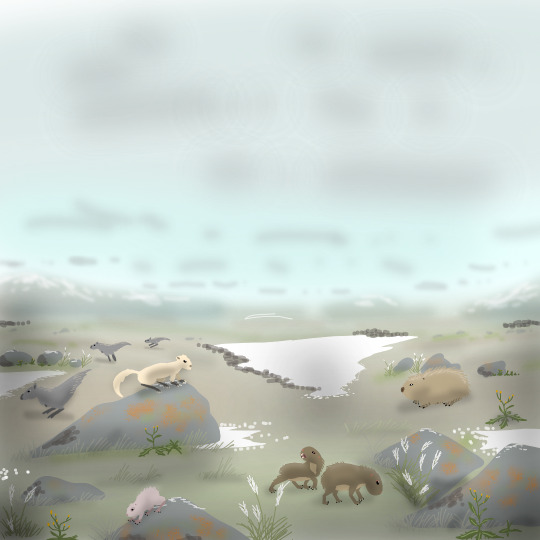
Whatever The Weather: Northern Tundras of Nodera
The planet of HP-02017 is a mostly temperate one as of the Middle Rodentocene, featuring a wide range of biomes and habitats across its continents and oceans. As the hamsters spread all across the globe throughout the millennia and begin to speciate and diversify, they begin adapting and specializing to each biome, and the many different opportunities and challenges each has to offer.
The northernmost latitudes of Nodera are no exception: despite its treacherous conditions, with temperatures regularly below 10°C and in winter plunging well into the negatives, the hardiest of lifeforms, adapted to the cold, make a living in the frigid temperatures in spite of its seeming inhospitability.
For six months at a time, the landscape is bare and barren: the soil frozen, the plants all dormant, the animals in hibernation until warm weather arrives. But come spring and summer, the flora bursts into bloom, germinating from cold-resistant seeds buried in the ground, and even as the soil above is still partly coated in swathes of snow and ice the landscape is quickly coated in a carpet of green. Among the first pioneers are lichens: hardy fungal-alga symbionts, they provide a ground cover acting as a buffer against temperature extremes, fix nitrogen from the atmosphere, and most importantly, provide food for a wide array of animals, especially during the cold winter months when there is nothing else to eat.
From these lichen-covered grounds soon sprout other vegetation in the form of true plants, such as tufted snowpuff (Arctograminiae spp.), grasses easily identified by their fluffy white floral spikelets, and tundra brassica (Cryobrassicae spp.), descendants of cultivated cabbages now more closely resembling its wild ancestral form. These plants are able to tolerate very cold temperatures thanks to natural antifreeze proteins in their cells that bind to forming ice crystals and halt their growth before they can damage the plants' tissues. These proteins are produced by the plants in response to changes in shorter day length and drier atmospheric conditions: a sign of the approach of winter.
With such an abundance of vegetation in a short span of time, the fauna of the tundra too begin to emerge. The largest of them, the tundra cavybara (Cricetochoerus arcticus), which can weigh as much as 30 kilograms, is a voracious consumer of lichens, grasses and brassica alike, having fasted in hibernation for the cold winter months. During its long sleep its metabolism slows down to a point that its heartbeat and breathing are nearly imperceptible: however, it resumes activity as the weather warms, losing up to a third of its body weight as it uses up all its fat reserves. Groups of up to twenty individuals share the same communal winter den, huddling together to conserve heat, but go their separate ways in the warmer months as they spread out to forage.
Other herbivores take advantage of the seasonal bounty of food, some traveling long distances to access them. Wooly jumpers (Tundrosaltocricetus borealis) are large, shaggy jerryboas, roughly 20 kilograms and weight and standing three to four feet tall, that typically range south in temperate zones closer to the equator, but migrate north to take advantage of the seasonal bloom. Their leaping gaits are highly efficient at covering large distances with minimal expense of energy, and thus they are well-suited to take advantage of the plentiful cold-weather plants. Roots and tubers, rich in stored nutrition, are a favorite of the alpine gootling (Frigicavicricetus arvicoloides), basal gouties that seek shelter among the rocky outcrops of the tundra and dig for underground rhizomes as they forage, with the sugary roots of tufted snowpuff being a particular favorite. Seeds, tough stems, and lichens attached to rocks, in turn, are the diet of choice for white snowsnips (Albucricetus leucis), tiny duskmice whose pale coloration camouflages them against the ice and snow, as well as the abundant white flowers of snowpuff in full bloom.
With plenty of herbivores active seasonally, it comes as no surprise that a local carnivore would take up residence in such prime hunting grounds and thus fill the niche of the tundra's apex predator. The arctic vermine (Cryomustelomys polaris), the most northernmost of the fearrets, is not a particularly large animal, only weighing about two kilograms and reaching two feet in length including its tail, yet it is able to take on prey larger than itself, such as the tundra cavybara. However, it is not very picky, and will take on smaller game as well if it can find them, particularly raiding nests of alpine gootlings trying to catch and kill as many as it can to store them in its den to eat later.
These times of plenty are fleeting, however, and as autumn and winter approach life fades from view and the land becomes icy and barren once more. Plants go dormant, or die off entirely, survived only by their overwintering seeds, and most of the animals begin returning to another six-month slumber, save for the wooly jumpers that begin their long trek south. Within days, as the ice blankets the tundra once again, not a sign of life is visible in the desolate landscape: yet it lies hidden for the moment, waiting to spring back to life when the warmer weather comes.
-----------
30 notes
·
View notes
Text
Schezo Wegey Guide
Before we begin, I'd like to remind everyone that these summations are based on my understanding of the characters, and what I've observed of them within the games. Sometimes, that comes with a little bit of extra analysis and headcanons, which are inherently interpretive. Those headcanons are not to be taken as the Absolute Authority on the characters. These entire guides are not meant to be Absolute Authority. They're about giving a good look at the characters as they're shown to us, based on what I know.
Also, follow-up questions are always welcome.
That out the way,
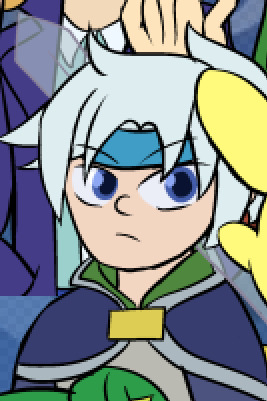
Schezo Wegey is motivited entirely by a never-ending desire to gain more power. So he says.
First thing's first, let's discuss his accidental double-entendre's. While it's extremely tempting to try to force as many of them as possible in his dialogue (I know I've been guilty of it), he doesn't make those slips that often.
Generally, his freudian slips happen when he's excited, flustered, or irritated. Or in other words, when he's not taking the time to actually think about the words he's saying.
(He is, after all, trying to break the habit) (via practicing his speech to a handmade doll) (that he made himself)
The slip-ups are of greatest effect when he forgets to say a word, or says the right words in the wrong order, or mispronounces something (as opposed to, for instance, saying the word "come" with weird emphasis)
One good example that actually comes from Puzzle Pop (despite how he is in the rest of the game): "If you don't feel capable of doing this yourself, I'd be happy to play with [Carbuncle] myself for this next match."
Most importantly, it's unintentional. That's the whole point.
Amitie (and perhaps Lidelle) doesn't know what the word "creeper" means, but since Arle calls Schezo a creeper, she does too. It's more of an affectionate nickname than an insult, coming from her
Schezo's age is unknown. Granted, most of the cast's exact age is unknown, but Schezo stands out in that there's not a clear frame of reference of how old he is beyond "older than 14 and younger than Satan," which encompasses a rather wide range of possible ages.
Other characters usually address him as a young man-- which is noteworthy, since Satan looks like a young man but is immediately pegged as a geezer.
(Personally, I read him as in his early- to mid-twenties)
A fairly common interpretation (at least in my circles) of his history is that Schezo's mind/personality was corrupted as part of the process of inheriting the power and title of Dark Mage from Runelord.
This corrupted Schezo was the one Arle met at the start of Madou 2: Schezo with a body count, Schezo with minions, Schezo looking to abduct and murder others for the sake of harvesting their magic from them.
This interpretation continues that, thanks to his interactions with the core Madou cast, Schezo eventually overcame the corruption, resulting in the Dark Mage we know now.
I personally think that losing his power to a spacetime crystal in Waku Puyo Dungeon was also a major factor to overcoming the corruption, in that said corruption was also taken from him. Schezo even bids farewell to his "former self" in that game.
Either way, it's a fact that he's not quite the edgey boy he used to be, and is aware of that fact.
He is still interested in becoming powerful, but is significantly less inclined to taking power by force, preferring to instead earn or win it.
But more than that, what he really wants is a life of peace and quiet. He will never get it.
And even more than that, he wants to keep close to Arle, Rulue, Witch, and (to an extent) Satan.
He once admitted to Arle that he needs her in his life. Arle just assumed he was trying to say "I want your power" again.
Perhaps he is scared of succumbing to corruption again in their abscence?
Schezo's preferred habitat is cave.
The cave in Primp Town that he's squatting in is one that used to be frequented by Klug (as seen in Fever 1). It's full of crystals that can be used for magic.
Despite living in a cave, he's still able to cook and bake as he feels a need to. How he manages it is an excellent question.
He adores cuteness and cute critters, but tries to not let it show around others. Acorn frogs, onion pixies, Carbuncle (sometimes), fish-mode Salde, palm-sized elephants, and Amitie's hat (with or without its power) are known subjects that endear him.
He and Witch are close, especially after Schezo saved her grandmother. And then declined to steal her magic immediately afterwords because of her weakened state.
They tend to bicker and/or try to exploit each other when they do bump into each other, however.
Schezo is analytical and observant, able to get accurate reads on people he spends time around when he cares to. It was he that figured out Ringo's fear of ghosts had nothing to do with them being "unscientific."
He also has powerful magic sensing ability, able to accurately detect how much magic power someone or something has on sight.
He can also determine the source of ongoing magical effects, if he's familiar with said sources.
He is able to communicate telepathically with the Dark Sword, though how often they communicate is unknown.
He's only ever silly as a means to an end. Anything beyond that is either an accident or concentrated sarcasm. Usually he has no patience for shenanigans, especially from other people.
He's not very patient about being around other people in general. This is a result of both introversion and social awkwardness (he does not know how to respond to positive interaction in the slightest).
The most likely of the regular cast to complain about the damn kids today (without being one of the damn kids himself).
62 notes
·
View notes
Text
Territory disputes between different kinds of dragons always have so much tension and I love it
Having a huge mountain range that borders a desert, each with their own dragon bigger than the average village. The sand dragon, burrowing and landlocked, with a breath hot enough to melt the sand around it, reaching the edge of it dunes to roar a challenge to the neighboring thunder dragon, whose been crystallizing its desert with sudden bursts of electricity. Neither can truly do much to the other, both being able to escape into their natural habitat, and if they do manage to get close enough to the other to challenge it would be mutually assured destruction. So they foray on the edges of their reach, each roaring to the other, trying to intimidate or tire out, rage and adrenaline so close to the boiling point but never quite able to let the aggression out, so they come back the following day to do the same, over and over for centuries. If you spoke to either, at first they’d spit nothing but vitriol at the other. But after centuries of having nothing but each other’s company, their words have softened, even slightly. After all, who else is there to listen to them? Who else but each other could possibly understand what it’s like to live like them. When sadness comes, is it really a surprise their theatrics fall to the wayside for a moment, just to offer the other a body large enough to hold?
50 notes
·
View notes
Text
Mugwort
Artemisia Vulgaris
Known as: Artemis herb, artemisia, artemisia herb, cingulum sancti johannis, felon herb, muggons, naughty man, old man, old uncle Henry, sailor's tobacco & St.John plant
Related plants: A member of the daisy family Asteraceae that consists of over 32,000 known species of flowering plants in over 1,900 genera within it such as chamomile, coneflowers, dahlia, daisy, dandelion, goldenrod, lettuce, marigold & sunflower
Parts used: Leaves & flowers
Habitat & cultivation: Common mugwort is native to Europe and Eastern Asia. Mugwort was brought into North America as early as the 1600’s for medicinal purposes. It spread throughout the Northeastern U.S. as a contaminant on ships and nurseries.
Plant type: Perennial
Region: 3-8
Harvest: The flowering tops of mugwort should be collected once they bloom or right before the blooms open. The leaves of mugwort plants should be collected before the plant flowers. Older leaves & flowers are significantly more bitter
Planting tips: Mugwort seeds can benefit from a special 1 to 2 week treatment called cold moist stratification prior to planting them & need cold weather to break down germination inhibitors. The seeds require light to germinate, so be careful not to cover them when planting. Mugwort does not like to be overwatered & is very drought tolerant. It is also an invasive weed & best kept in a container.
Medicinal information: Historically mugwort has been used in traditional systems of medicine in different parts of the world. Today, mugwort taken orally is promoted for digestive problems, irregular menstruation, and high blood pressure. It is also promoted as a sedative, laxative, anti-inflammatory & liver tonic. Mugwort lotion applied topically can aid in itching caused by hypertrophic scars & When being smoked, it exhibits mild intoxicating properties & strong relaxing properties.
Cautions: Mugwort should not be taken by pregnant people because it may start menstruation and cause the uterus to contract. Little is known about whether it’s safe to use mugwort while chestfeeding. Mugwort might cause an allergic reaction in people with pollen sensitivities
Magickal Properties
Gender: Feminine
Planet: Venus & Neptune
Element: Earth
Deities: Aida Wedo, Artemis, Diana, Isis, Lakshimi & St.John
Magickal uses:
•Place under your pillow to bringing peaceful sleep, prophetic dreams & aid in astral travel
• Add to incense for cleansing and clearing energy
• Place around scrying tools to increase their energy
• Add to herbal smoke blends to stimulate lucid dreaming, astral travel & visualization
• Make an infusion of mugwort to wash magic mirrors and crystal balls to aid in physic workings
• Burn with Sandalwood or wormwood for scrying rituals
• Carry in a satchets for protection and increasing lust, fertility & preventing back pain
• Throw mugwort in a fire during Midsummer for protection for the following year
• Keep under your doorstep to keep annoying visitors away
• Use in tea before bed to encourage lucid dreaming
• Hang mugwort over or on a door to keep unwelcome energies from passing through
• During a storm or when your life feels threatened by impending dangers, toss into your hearth fire or cauldron to keep you safe
•Wash your hands with a mugwort infusion to increase energy flow before tarot or pendulum readings
Sources:
Farmersalmanac.com
The Herbal Alchemist Handbook by Karen Harrison
The Book of Flower Spells by Cheralyn Darcey
Llewellyn's Complete Book of Correspondences by Sandra Kines
A Witch's Book of Correspondences by Viktorija Briggs
The Encyclopedia of Natural Magic by John Michael Greer
Wild Witchcraft by Rebecca Beyer
Plant Witchery by Juliet Diaz
A Compendium of Herbal Magick by Paul Beyerl
Wikipedia
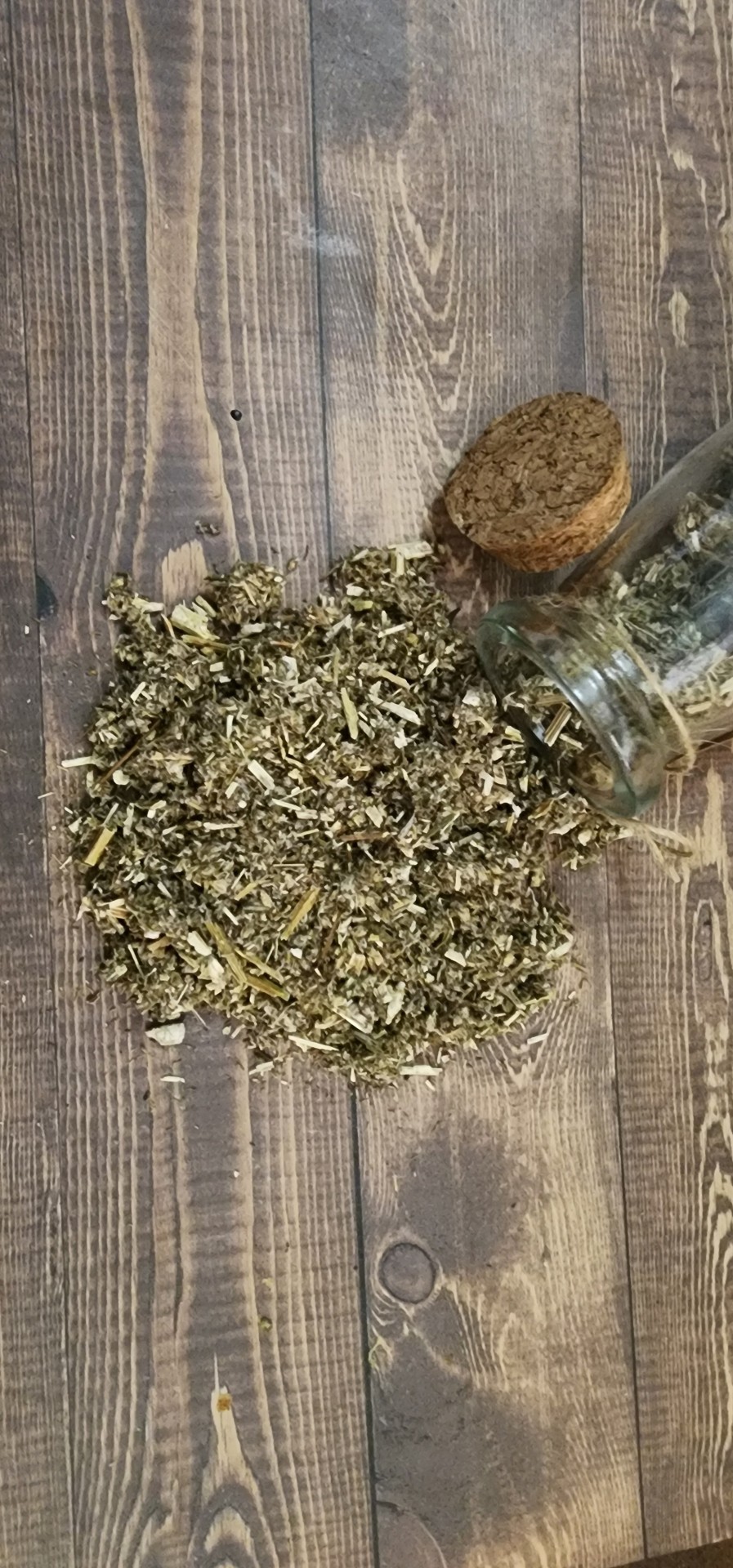
#correspondence#witch guide#mugwort#witchblr#wiccablr#paganblr#spiritual#witch community#witchcraft#witches of tumblr#tumblr witches#tumblr witch community#grimoire#book of shadows#spellbook#spells#spellwork#witch tips#baby witch#beginner witch#witch tumblr#green witchery#green witch#magical herbs#traditional witchcraft#witch#witchcore#baby witch tips#spell casting#GreenWitchcrafts
390 notes
·
View notes